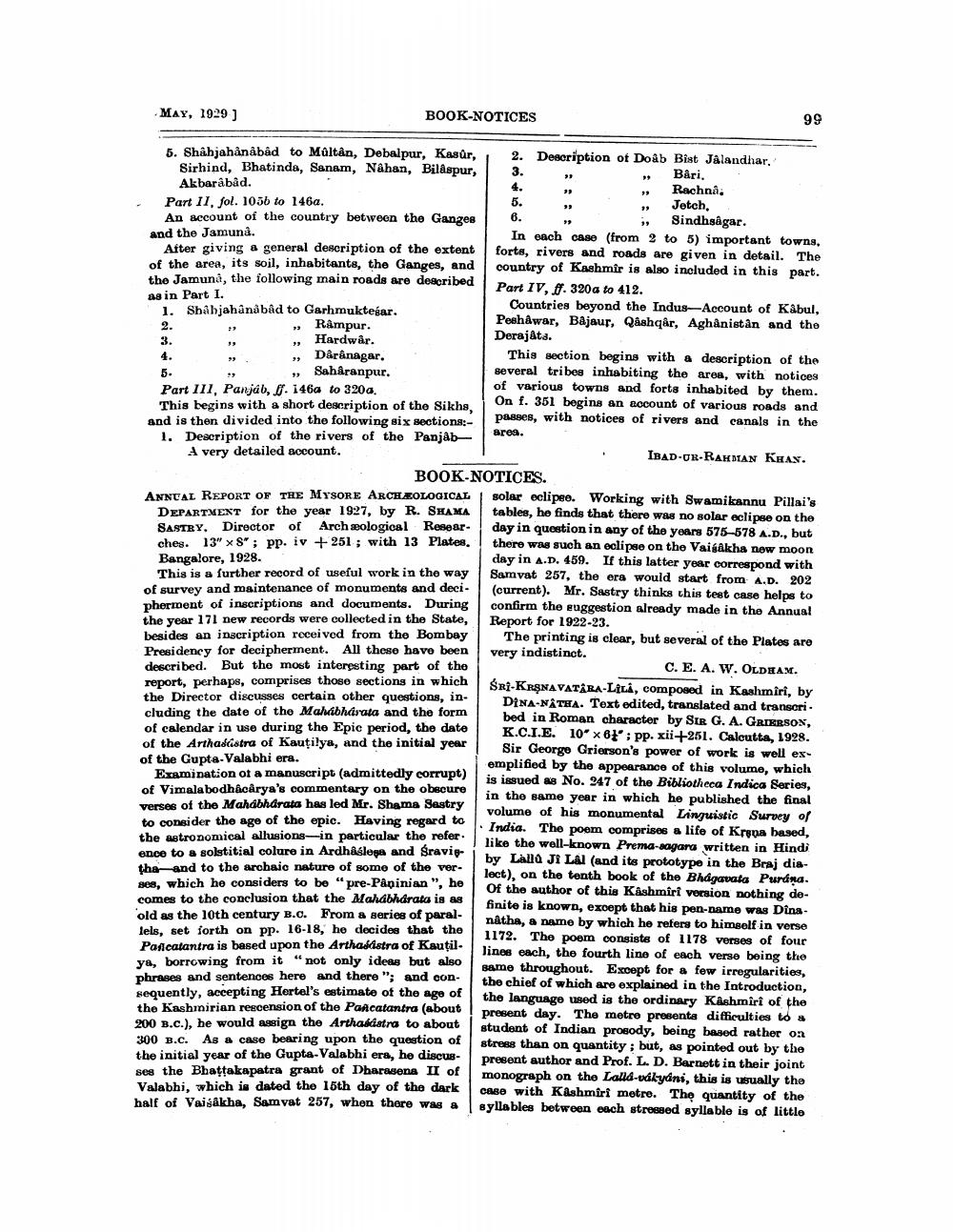________________
MAY, 1929 )
BOOK-NOTICES
99
6.
ci
5. Shahjahånåbåd to Multân, Debalpur, Kasûr, 2. Description of Do&b Bist Jalandhar. Sirhind, Bhatinda, Sanam, Nahan, Bilaspur,
Bári. Akbarabad.
Rachna. Part II. fol. 1056 to 146a.
Jetch. An account of the country between the Ganges
i Sindhsågar. and the Jamuna.
In each case (from 3 to 5) important towns. After giving a general description of the extent forts, rivers and roads are given in detail. The of the area, its soil, inhabitants, the Ganges, and country of Kashmir is also included in this part. the Jamuna, the following main roads are described
Part IV, ff. 320 a to 412. as in Part I.
Countries beyond the Indus-Account of Kabul, 1. Shahjahandbâd to Garhmuktegar. Râmpur.
Peshawar, Bajaur, Qashqår, Aghanistan and the , Hardwâr.
Derajata. , Daranagar.
This section begins with a description of the Saharanpur.
several tribes inhabiting the area, with notices Part III, Panjab, f. 1469 to 320a.
of various towns and forts inhabited by them. This begins with a short description of the Sikhs,
1 On f. 351 begins an account of various roads and and is then divided into the following six sections:
passes, with notices of rivers and canals in the
area. 1. Description of the rivers of the PanjabA very detailed account.
IBAD-UR-RAHDIAN KEAs.
BOOK NOTICES. ANNUAL REPORT OF THE MYSORE ARCHEOLOGICAL solar eclipee. Working with Swamikannu Pillai's
DEPARTMENT for the year 1927, by R. SHAMA tables, he finds that there was no solar eclipse on the SASTRY. Director of Archaeological Resear. day in question in any of the years 575-578 A.D., but ches. 13" x S; pp. iv +251 ; with 13 Plates ! there was such an eclipse on the VaigAkha now moon Bangalore, 1928.
day in A.D. 459. If this latter year correspond with This is a further record of useful work in the way Samvat 257, the era would start from A.D. 202 of survey and maintenance of monuments and deci. (current). Mr. Sastry thinks this test case helps to pherment of inscriptions and documents. During confirm the euggestion already made in the Annual the year 171 new records were collected in the State, Report for 1922-23. besides an inscription received from the Bombay The printing is clear, but several of the Plates are Presidency for decipherment. All these have been very indistinct. described. But the most interesting part of the
C.E. A. W. OLDEAM. report, perhaps, comprises those sections in which
ŚR]-KRŞNAVATARA-LILA, composed in Kashmiri, by the Director discusses certain other questions, in
DINA-NATHA. Text edited, translated and transori cluding the date of the Mahabharata and the form
bed in Roman character by SIR G. A. GRIERSON, of calendar in use during the Epic period, the date
K.C.I.E. 10' x 61: pp. xii +251. Calcutta, 1928. of the Arthascistra of Kautilya, and the initial year
Sir George Grierson's power of work is well exof the Gupta-Valabhi era.
emplified by the appearance of this volume, which Examination of a manuscript (admittedly corrupt)
is issued as No. 247 of the Bibliotheca Indica Series, of Vimalabodhâcârya's commentary on the obscure
in the same year in which he published the final verses of the Mahabharata has led Mr. Shama Sastry
volume of his monumental Linguistic Survey of to consider the age of the epic. Having regard to
India. The poem comprises a life of Kropa based, the astronomical allusions in particular the refer
like the well-known Prema-sagaru written in Hindi ence to a solstitial colure in Ardhaslesa and Śravie
by Lallu Ji Lal (and its prototype in the Braj diathaand to the archaic nature of some of the ver
lect), on the tenth book of the Bhagavata Purana. ses, which he considers to be "pre-Papinian", he
Of the author of this Kashmiri version nothing decomes to the conclusion that the Mahabharata is as
finito is known, except that his pen name was Dina. 'old as the 10th century B.C. From a series of paral
nátha, a name by which he refers to himself in verse lels, set forth on pp. 16-18, he decides that the
1172. The poem consists of 1178 verses of four Pascatantra is based upon the Arthascistra of Kautil.
lines each, the fourth line of each verse being the ya, borrowing from it “not only ideas but also
same throughout. Except for a few irregularities, phrases and sentences here and there"; and con
the chief of which are explained in the Introduction, sequently, accepting Hertel's estimate of the age of
the language used is the ordinary Kashmiri of the the Kashmirian recension of the Pancatantra (about
present day. The metre presenta difficulties to 200 B.C.), he would assign the Arthaddatna to about
student of Indian prosody, being based rather oa 300 B.C. As a case bearing upon the question of
stress than on quantity ; but, as pointed out by the the initial year of the Gupta-Valabhi era, he discus
present author and Prof. L. D. Barnett in their joint ses the Bhattakapatra grant of Dharasena II of
monograph on the Lalla-udkydni, this is usually the Valabhi which is dated the 16th day of the dark case with Kashmirf metro. The quantity of the half of Vaisakha, Samyat 257, when there was a syllables between each stressed syllable is of little




